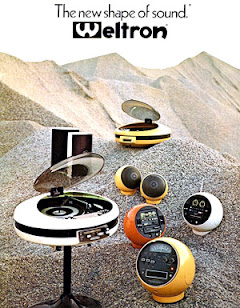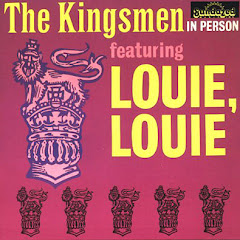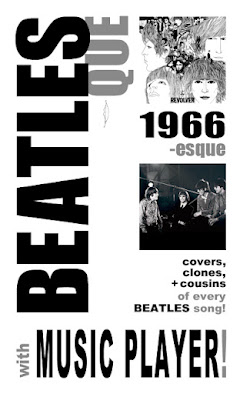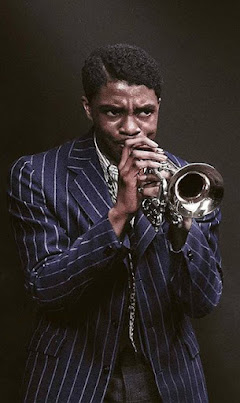Music Player!
international Rock'n'Roll music,
in order from 1947 to 1960!
by Tym Stevens
Hear the unlimited 600-song Playlist here.)
brings you the actual, all-inclusive history of Rock'n'Soul music,
with essay overviews and Music Playlists.
▶ History Checklist
Let's start with the Big Bang itself, 1950s Rock'n'Roll.
Until 1955, radio belonged to the adults in America.
The Popular Music charts were mainly somnolent syrup lulling war-weary elders into a saccharine trance. Music was the loll of reassurance and restraint. But small record labels, jukeboxes, and night owl radio waves changed that. The youth heard crazy voices whispering from this alien ether and acted on them. Overnight the word 'Pop' became a whole new universe, a joyful free-for-all, where everything combined and recombined in endless new shapes. What had been became everything that would be, blendered in the restless energy of the young.
What were the seeds of this cultural revolution?
Sax and electric guitar were a new jolt to Jazz in the decade before, leaping in and carousing like a drunk crasher. Their raunchy edge whipped the crowds crazy into communal spasms like the modern age had never seen. Swing Jazz orchestras pumped the war years up with brassy horn sections and liquid crystalline guitar. But war shortages pared the big bands down to quartet combos, easier to fit in a car and feed. In the late 40's these trimmed-back troubadours pounded out Jump Jive and Boogie Woogie to kids from coast to coast. The primal pulse was that Boogie. It shook hips without shame from juke joints to hoedowns nationwide. To this raw rhythm was added the refined sound of electric guitar. Les Paul and his cohort Mary Ford reeled off lightning licks so complex, mercurial, and high-pitched they sounded like they were chiming in from another world. And every kid with a twanger for thirty years would take notice.
Gutbucket Blues framed the skeleton of Rock. That wrestle with the Devil, with conscience, with life, all with laughing abandon. And that hard clang, that terse swagger, that moody intonation. Blues was the edge, the truth. It infects blazers like Big Mama Thornton's "Hound Dog", LaVern Baker's "Jim Dandy", and Chuck Berry's "Reelin And Rockin" with its ambivilent zest.
Country hit a hard-twanging gallup in the early-'50s with Honky Tonk music. While many blues masters scowled terse chords, hillbilly sages barnstormed the hayrides with blue streak riffs honed out of Bluegrass. It was the heady mix of blues fuel with country wildfire that ignited Rockabilly. Country riffs are rife throughout songs like Chuck Berry's> "Too Much Monkey Business", Joe Clay's "Duck Tail", Carl Perkins' "Put Your Cat Clothes On", Ricky Nelson's "Believe What You Say", Little Jimmy Dickens' "I Got a Hole In My Pocket", and the hypersonic string wizardry of Joe Maphis and his 13-year-old accomplice, Larry Collins.
But Rock'n'Roll was no chess game, no black and white, not just Country and Blues.
It's a shock, I know, but listen up. Or rather, just listen to those records again, and look closer at the people making them. Like all actual culture, it was a jigsaw puzzle. Simultaneously it was splicing strings from Classical, slide from Hawaii, syncopation from Cuban Jazz, two-step from Tex-Mex, eerieness from Electronic music, and Folk strains from all immigrant traditions.
Culture isn't constant or owned by a pure group. Culture is constantly renewing itself through everyone.
It is an intersection of ideas. We refract everything we've taken in. From each other, with each other, for each other.
Country kids (such as my Dad) hid radios under their pillows to taste all of the flavors of the world beyond and then became radio beacons made flesh. Soundwaves bypass all boundaries, whether on maps, in cultures, or in one's head.
Kindergarten activists who knock Elvis for singing a Blues song miss the point; he also sang Bluegrass, Pop, and Gospel songs in the same breath, and channeled them without the barriers. He made further music out of the music that he lived and breathed. Using a separatist model of colonialism on him would be ludicrous and oversimplified. Similarly, but unnoted, Chuck Berry and Bo Diddley> made their breakthroughs based on Country songs simultaneously.
Elvis, like his generation, was the fruition of tearing down all separations. Rather than a King, he was part of a pantheon of young men and women rethinking the future. There was no ruler because there were no more rules. Everyone was king and queen, if only for a performance, a 45, a school dance, a love affair, a night ride, a new idea shared.
The '50s was a smorgasbord, with sooo many flavors to choose from. Fats Domino tickling Crescent City piano rolls. The Big Bopper possessed by Jump Jive. The Five Satins converting Gospel chorals into soaring teen lust. Little Richard> roaring out barrelhouse Blues past the speed of tongue. The Coasters trajecting the Marx Brothers through Rhythm and Blues. The Drifters wafting over epic string sections. Ronnie Self sneering wanton through Honky Tonk. The mighty Howlin' Wolf gargling gravel and electric Blues. The Everly Brothers countrifying the celtic hymn tradition. Santo And Johnny and The Ventures sailing out into the first ripples of Surf to come, with Mediterranean, Hasidic, and other worldly melodies churning beneath.
And the personalities. The smooth spacefaring glee of Mary Ford. The smoldering satisfaction of Ruth Brown. The cocksure Bo Diddley. The ethereal Platters, wings to the archangel Tony Williams. Lascivious Presley. The ever charming Carl Perkins. That hellion Wanda Jackson, so fair and fierce. The riotous theatrics of The Coasters and Don And Dewey. The eerie dreamscape of The Flamingos. The intense urgency of the seeming everyman Buddy Holly>. The startling virtuosity of Jackie Wilson's performance of "Lonely Teardrops". And sweet Gene Vincent, blasting headlong and hardscrabble.
The Big Bang of Rock'n'Roll detonated ideas, debunked constrictions, fractured the status quo, burst past borders, blasted revelation, and birthed revolutions. Even as US politicians, bonfires, and disc jockeys moved to contain the shock, its waves already rebounded through the world.
Creativity is crossroads. Rock'n'Roll is a tryst of combined intimacies that deepen the soul and expand the mind. Boogie and Mambo (Cuarteto Don Ramon, Celia Cruz, Fay Simmons, Georgia Gibbs), Boogie and Country-Western (Merle Travis, Skeeter Davis, Big Joe Turner), Honky-Tonk and Boogie Blues (Forrest Sykes, Hank Williams, Clarence "Gatemouth" Brown, Bill Doggett), Rock and Gospel (Sister Rosetta Tharpe), along with Cha-Cha-Cha (Richard Berry's original "Louie Louie", Rene Touzet, Tiny Topsy) and Cajun (Hank Williams, Chiemi Eri, Dave Bartholomew) and Jazz (Peggy Lee, John Barry, King Curtis, Margie Anderson) everywhere. Human arts flow from heart to heart, and leave delusional limits in the dust.
Doo Wop came out of the Gospel quartet tradition, but went lateral lickety-split. Las Hermanas Navarro from Mexico were covering "Sh...Boom (Cancion Pop)" in 1954. There were many other all-female Doo Wop acts like The Debs, Gay Charmers, and Vikki Nelson. There were female-and-male acts like The Six Teens, The Platters, and Los Cincos Latinos (Argentina). The Crests ("16 Candles") had one female, one Italian-, one Puerto Rican-, and three African-American members.
Segregation in the USA was a repressive martial law that went against the inclusive, diverse core of the immigrant nation, and it was already being overthrown in the music and on the dance floors. And around the world.
From 1956 onward, there was Rock music in Mexico (Los Rebeldes del Rock, Los Teen Tops), Canada (The Diamonds), Jamaica (Laurel Aitken), Cuba (Perez and Brana), Brazil (Celly Campello), Spain (Los Estudiantes), Africa (Jimmy Masuluke), England (Tommy Steele, John Barry), France (Johnny Hallyday, Catarine Caps), Germany (Little Gerhard), Sweden (Owe Thornqvist, Rock-Olga), Italy (Adriano Celentano), New Zealand (Max Merritt, Johnny Devlin), Australia (Johnny O'Keefe), South Korea (Shin Jung-hyeon), and Japan (Billy Morokawa, The Peanuts).
And, as in all things, women were straight there with it, just as strong for the long with every song. Big Mama Thornton, Ella Mae Morse, Ruth Brown, Wanda Jackson, Sister Rosetta Tharpe, Janis Martin, LaVern Baker, Lorrie Collins, Etta James, and The Chantels, a singing band who played their own instruments. Emancipation exclamation.
These voices gave voice to all the un-adults, to their dreams, pains, schemes, and refrains. It lit the secret night like a clarion call only they could hear and act upon. It understood the addled essence of adolescence, the comedy of errors that was their lot. It promised them a world without constriction where anything could happen, if they took up the call...
In 1955, the future belonged to the young.
© Tym Stevens
See also:
• The Real History of Rock and Soul!: A Manifesto, A Handy Checklist
• 1950's PUNK: Sex, Thugs, and Rock'n'Roll!, with Music Player!
• CHUCK BERRY: The Guitar God and His Disciples, with 2 Music Players!
• BO DIDDLEY: The Rhythm King and His Disciples, with 2 Music Players!
• BUDDY HOLLY: Rock's Everyman and His Disciples, with 2 Music Players!
• LITTLE RICHARD: The Voice of Rock and His Disciples, with 2 Music Players!
• JIMMY REED: The Groover of Rock, From Motown To Sesame Street, with 2 Music Players!
• 1950s Rock, A: The '60s Disciples, with Music Player!
• 1950s Rock, B: The '70s Disciples, with Music Player!
• 1950s Rock, C: The '80s disciples, with Music Player!
• 1950s Rock, D: The '90s disciples, with Music Player!
• 1950s Rock, E: The 2000s disciples, with Music Player!
• 1950s Rock, F: The 2010s disciples, with Music Player!















































































































































No comments:
Post a Comment